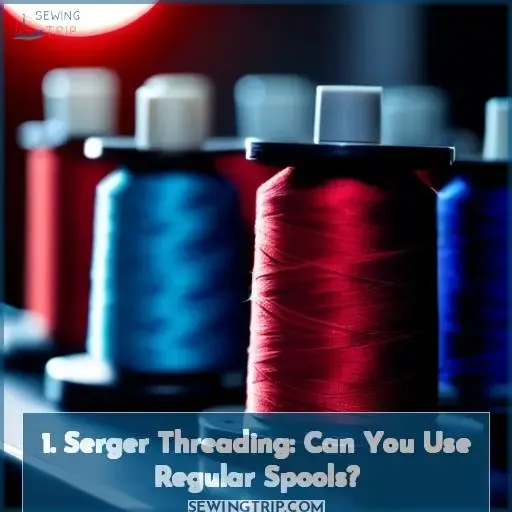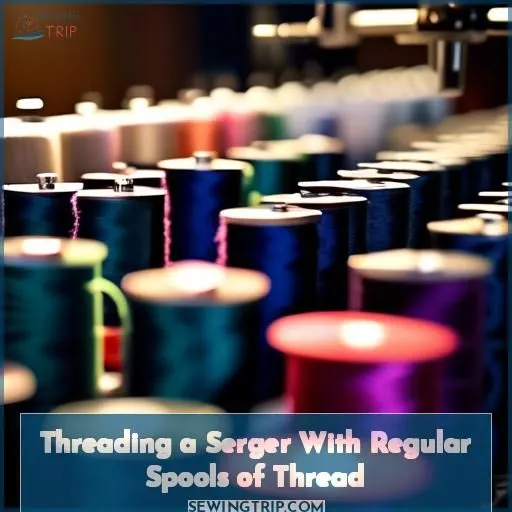This site is supported by our readers. We may earn a commission, at no cost to you, if you purchase through links.

Yes, you can utilize regular spools of thread on a serger. To guarantee your serger performs seamlessly, thread it in the proper sequence and adjust the thread tension accordingly. It’s crucial to align the thread colors for a consistent appearance and to store your thread appropriately to prevent tangling. Don’t neglect to test your stitches to verify their quality.
If you seek alternatives, consider utilizing a sponge disc and spool cap for improved thread management. By adhering to these guidelines, you’ll preserve your serger’s functionality and enhance the longevity of your threads.
For additional insights into threading techniques and thread management, there’s more to discover.
Table Of Contents
Key Takeaways
- Regular spools of thread can be used on a serger, but they require proper threading and tension adjustments.
- Using a sponge disc and spool cap can improve thread management.
- High-quality serger thread is recommended for best performance and durability.
- Regular thread can be used in a serger for the lead stitch when sewing knits, but tension settings may need to be adjusted.
Can You Use Regular Spools of Thread on a Serger?
Yes, you can use regular spools of thread on a serger, but adjustments like tension modification and using spool caps for smooth feeding may be necessary.
Threading a Serger With Regular Spools of Thread
Threading a serger with regular spools of thread is possible, but it requires some adjustments to guarantee proper tension and thread flow. Here’s how to do it:
- Thread the machine in the proper order: Start with the upper looper, then the lower looper, and finally the needles. This guarantees that the thread is guided correctly through the machine.
- Use the correct thread tension: Adjust the tension settings on your serger to accommodate the different thread weights and types. Regular sewing thread may have a slightly different tension than serger thread, so you may need to make some adjustments.
- Match thread colors: If you’re using regular thread for the needle, make sure it matches the color of the serger thread in the loopers. This will help maintain a consistent appearance on the right side of your project.
- Store thread properly: Keep your thread spools in a cool, dry place to prevent damage and guarantee that the thread remains tangle-free.
- Test your stitches: Always test your stitches on a scrap piece of fabric before sewing on your actual project. This will help you identify any issues with tension or thread flow.
- Adjust thread tensions: Different thread weights and types may require adjustments to the thread tension settings on your serger. Be prepared to make adjustments as needed.
Alternatives to Regular Spools of Thread for Sergers
Regarding the use of standard spools of thread on a serger, there are some options to contemplate. Here are five suggestions to guide you:
- Utilize a sponge disc and spool cap: Position a sponge disc on the spool to prevent it from bouncing, and employ a spool cap of appropriate size to impede the thread from feeding improperly into your serger.
- Thread the machine in the correct sequence: Adhere to the color-coded guide to thread for various stitches, and thread each cone in the proper order (e.g., upper looper initially, lower looper subsequently, right needle thirdly).
- Consider using multipurpose polyester thread: The thread employed in your sewing machine can be utilized in your serger as well, but remember that the yardage required for sewing will differ.
- Inspect your machine’s screws: Certain sergers require threading to a specific point, followed by completing the threading process by propelling the thread along the path with a burst of air.
- Utilize thread nets and spool caps: Thread nets prevent thread from slipping off the cone, and spool caps assist in ensuring that the thread is fed correctly into your serger.
Frequently Asked Questions (FAQs)
What is the recommended thread weight for using regular spools of thread on a serger?
To use regular spools of thread on a serger, you should choose a thread weight that’s suitable for the type of fabric you’re working with. Medium weight threads, such as 40 or 50 wt., are commonly used for most construction, quilting, and general purpose sewing, including sergers.
However, it’s recommended to use high-quality serger thread, which is finer than standard sewing thread and designed for multi-thread stitching. This thread is typically sold on large cones and is more expensive than regular spools of thread, but it’s necessary for best performance and durability.
Can I use a spool cap on a serger to prevent thread from tangling?
Yes, you can use a spool cap on your serger to keep that pesky thread from tangling. It’s like putting a lid on chaos, ensuring smooth sailing through your serging journey.
How do I adjust the tension when using regular spools of thread on a serger?
To adjust the tension when using regular spools of thread on a serger, follow these steps:
- Thread the machine with the regular spool of thread in the correct order: upper looper, lower looper, needles.
- Use the correct needle type and size for your fabric.
- Evaluate the thread tension in the same order that you threaded. Begin with the upper looper, then lower looper, then right needle.
- Adjust the tension settings on your serger to create different stitches and finishes.
- Make one adjustment at a time and then serge to see if the stitch quality has improved.
- Tighten the needle tension if loops or V’s form on the underside and the seam may pull apart.
- Loosen the needle tension if the fabric puckers.
- Loosen the upper looper tensions or tighten the lower looper tension if threads pucker or draw in.
- Tighten the upper looper tension or loosen the lower looper tension if threads are too loose and gappy.
- Remember to oil the machine as specified in the manual and dust frequently to prevent thread tangling.
What type of thread should I use for serging thin knit fabrics?
To serge thin knit fabrics, you should use a high-quality synthetic thread, such as polyester or a corespun polyester thread specifically designed for serging. This type of thread offers excellent strength and elongation, ensuring smoother stitches with less puckering.
Avoid using inferior quality threads or old cotton threads, as they may not provide the necessary stretch and durability for knit fabrics.
Can I use regular thread in a serger for the lead stitch when sewing knits?
Yes, you can use regular thread in a serger for the lead stitch when sewing knits. However, it’s crucial to alter the tension settings on your serger based on the thread type you’re using. Regular thread is marginally thicker than serger thread, so you may need to make some adjustments to obtain the preferred stitch quality.
Conclusion
Traversing the realm of serger threading with conventional spools of thread is akin to navigating a vessel through placid waters; it’s entirely feasible and can lead to seamless progress. By threading your serger in the correct sequence, adjusting thread tension, and utilizing a sponge disc and spool cap, you guarantee that your endeavors appear polished and professional.
The key to success lies in diligent thread management and practice. You can employ regular spools of thread on a serger, augmenting your sewing arsenal.








